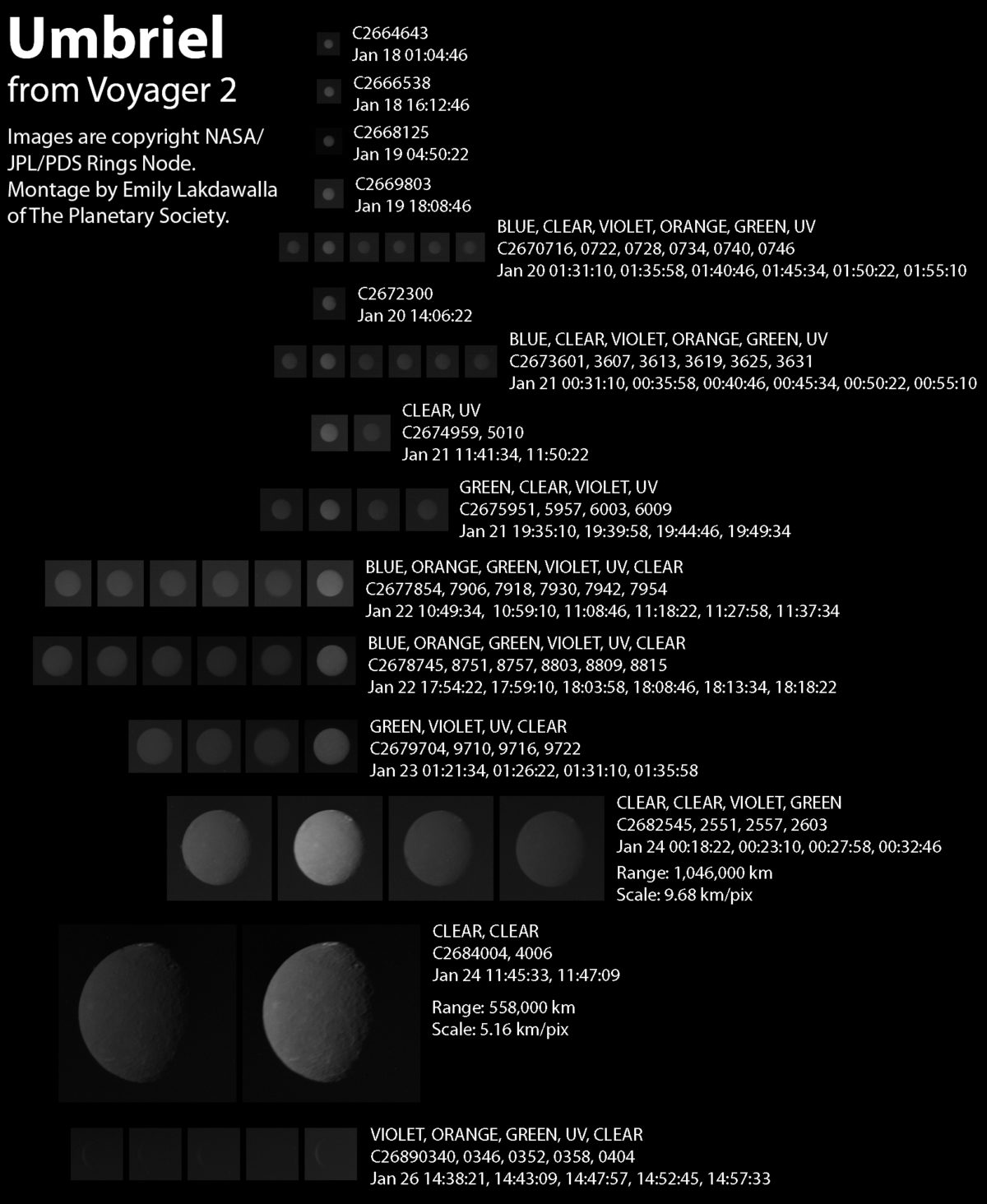Emily Lakdawalla • Feb 19, 2009
What do we know about Uranus' moons? Part 2
A few weeks ago I posted the result of my noodling around for a while with the Voyager 2 image catalogs from Uranus. As amazing and inspiring a mission as Voyager 2 was, its data sets from Uranus and Neptune are quite limited in size; it's possible to put together in one montage every single image it took of each of Uranus' moons without driving yourself insane. My earlier post featured every single Voyager 2 photo of Miranda, Ariel, and Oberon; here are every single image of the last two moons discovered prior to the Voyager 2 encounter, Titania and Umbriel. Voyager 2 didn't get particularly close looks at either one.


While composing captions for these images, I realized that most of the sources I was looking at for caption material consisted of scientists' first impressions of these worlds. Has anybody been studying any of them recently? Has the science changed at all from those first impressions? For answers, I began doing some searches in the NASA Astrophysics Data System, a wonderful, searchable database of astronomy-related publications. As I expected, the satellites of Uranus haven't exactly been a hotbed of research activity, but there has been a fairly regular trickle of publications by different researchers, well-known planetary geologists, planetary astronomers, and their students. So now this project has taken me in another direction, finding out what the last two-plus decades of research have added to our understanding of the moons of Uranus. So far, I've only looked into the papers from Ariel. Here's some of the highlights:
- Will Grundy and Leslie and Eliot Young reported the results of infrared observations using the SpeX instrument at the 3-meter Infrared Telescope Facility (IRTF) on Mauna Kea close to the Uranian system's equinox, the only time of Ariel's year when its rotation causes it to show completely different faces to Earth. They found that Ariel, like the moons of Jupiter and Saturn, has a leading-trailing dichotomy (that is, the side that faces forward along its orbit has different characteristics from the side that faces backward). They found evidence for carbon dioxide on the trailing but not leading hemispheres. (Abstract presented to the AAS DPS meeting in 2002: "Discovery of leading-trailing asymmetry and CO2 ice on Ariel," followed by a 2006 paper in Icarus with three other coauthors, "Distributions of H2O and CO2 ices on Ariel, Umbriel, Titania, and Oberon from IRTF/SpeX observations.")
- Olga Prieto and Jeff Kargel mapped the blocks of crust that shifted as a result of the faulting on Ariel, and examined their margins. They found that some scarps were four kilometers high, and that the walls of some scarps appeared to expose brighter material than the stuff on the surface -- probably nearly pure water ice, whereas the surface is dirty. (Abstract presented to the LPSC in 1997: "The interior structure and paleogeography of Ariel.")
- Guy Consolmagno, Dan Davis, and Paul Nyffenegger mapped the orientations of the flat-floored faults on Ariel and state that the orientation "is far from random, and these cracks probably arose from stresses due to the flexing of a tidal bulge and the despin of the planet. A statistical analysis of the cracks suggests that the location of the tidal bulge at the time of their emplacementmay have been 60 degrees east of the current sub-planetary point." (Abstract presented to the LPSC in 1994: "Has the tidal bulge on Ariel shifted in longitude?)
I'm rueful about the fact that I keep coming back to the subject of the moons of Uranus. Why do they fascinate me so much? I guess it's because they (like the moons of Neptune, which I'm sure I'll get to once I've wrung this subject dry) just don't get the respect they deserve, because there's been no dedicated mission to either world; and it's probably because Voyager 2's Uranus and Neptune encounters are ones I actually experienced when they happened, seeing the news reports and nature shows produced as the images trickled back from the ever-more-distant spacecraft. It must be the same way that those of you who were coming of age in the '60s and '70s feel about the landscapes of the Moon and Mars. So bear with me -- you'll likely see more from me about the moons of Uranus and Neptune!
Support our core enterprises
Your support powers our mission to explore worlds, find life, and defend Earth. You make all the difference when you make a gift. Give today!
Donate

 Explore Worlds
Explore Worlds Find Life
Find Life Defend Earth
Defend Earth

